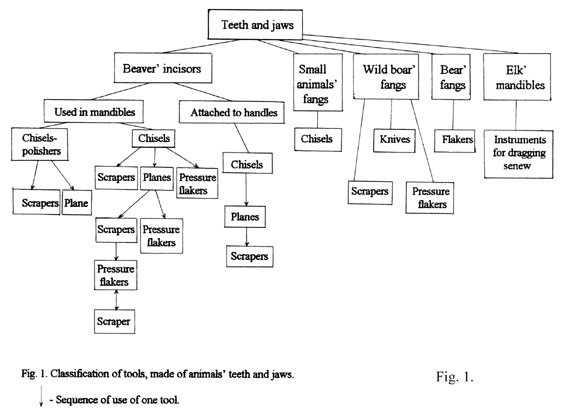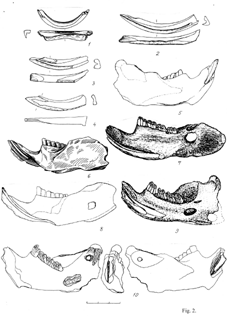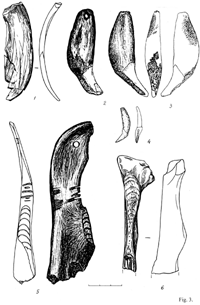
Published in: Proceedings of the 3rd EAA Meeting. Ravenna, 1997. BAR International Series, 1998.
Mickle G. Zhilin
Artifacts Made of Animalsí Teeth and Jaws in the Mesolithic of Eastern Europe.
Judjing by the ethnographic and scarce archaeological evidence, artifacts, made of teeth and jaws of various animals, played an important role in tool kits of hunter-gatherers of the forest zone of Eurasia and Northern America. Several times such tools were found at the Mesolithic peat sites of Northern and Eastern Europe (Clark, 1936; Oshibkina, 1983), but they were never a case for a detailed study.
Large-scale excavations, carried out during last decades in the forest zone of Eastern Europe, gave a good opportunity for such study. A series of 443 artifacts was selected from Veretye 1(106 tools) and 8 Mesolithic peat sites, excavated by the author on Upper Volga, dated by pollen and C-14 from the beginning of the Preboreal up to the Early Atlantic (about 9900 - 7000 B.P - Zhilin, 1993, 1995). Technological and traceological analises were carried out. More than 100 skulls and jaws of modern animals, mostly beavers, were studied for comparison in the Zoological Museum in Moscow. As a result, various tools were identified, classified according to the animal species, tooth type and the use of an artifact (fig. 1).

Tools, made of beaverí mandibles and incisors are the most abundant (410 artifacts). They are divided into two large groups. The first one (362 artifacts) is composed by incisors, which were used in mandibles, when the end or side of the incisor was a working edge, while the body of a mandible served as a handle of the tool (fig. 2: 5-10). The coronoid prong was broken off from all these mandibles, the edge of the breakage was sometimes carefully blunted with abrupt retouching to prevent damage of the hand. Such treatment of the mandible is diagnostic enough to be sure, that it was used as a tool, even when the incisor is missing. Besides this, the joint prong is also broken off from about half of the studied tools (fig. 2: 6-8). Use-wear, observed on these mandibles, includes smoothing and bright polishing of all elevations, usually with various striations, running in different directions, often crossing each other. Such traces were left by a hand, which held the mandible as a handle of a tool. One such mandible, bound across with a strip of a birch bark, was found in Veretye 1 (Oshibkina, 1983). Pieces of leather might also had been used for such purpose. Many mandibles have a hole, pierced by a sharp hammerstone either just below the joint prong, or at the lower angle of the mandible (fig. 2: 6-10). These holes were made for hanging the tool, probably at the belt, and sometimes well pronounced traces of attrition and bright polishing are observed at the part of a hole, opposite to the edge of the incisor.
 |
Fig. 2. Tools, made of beaverí incisors and mandibles: 1 - Ivanovskoye 7, III layer; 2, 5,9 - Stanovoye 4, III layer; 3- Ivanovskoye 7, IV layer; 4, 8 - Okayomovo 5, III layer; 6,7 - Ozerki 5, IV layer; 10 - Stanovoye 4, IV layer.
|
Use-wear traces indicate, that all incisors with preserved cutting end of a tooth, were used as chisels for wood carving. Traces of wear are almost the same, as observed at modern beaverí incisors: dulling of the edge, bright polishing of the enamel with short and longer (up to 12 mm) clear cut striations, running from the edge along the axis of the incisor or at acute angles to it, often crossing each other. The use-wear on tools is, nevertheless, much heavier, edge damage is usually well pronounced, and in many cases one corner of the working edge is worn to a greater degree, with striations, running at an angle about 45í to the axis, what is not characteristic of the use-wear, produced by a beaver itself. As a result of strong pressure, applied to the edge of the incisor, the latter usually sunk into the body of a mandible, protruding only about 1 cm from it (fig. 2, 5), and not 2-2,5 cm, as it is in unused mandibles, both modern and ancient. The base of the root was crushed into pieces, and portions of the lower part of the body of the mandible were sometimes cracked and broken.
Some beaverí mandibles display a hole 5-8 x 8-22 mm, pierced with a help of a sharp hammerstone at the basal part of the incisorís root at the lingual part of the mandible (fig. 2, 9-10). Several such tools are supplied with a piece of wood, put into these holes (fig. 2, 10) to prevent the incisor from sinking into the mandible. Such treatment is a clear indication, that the tool served as a chisel for wood carving, even when the incisor is missing.
In several cases the edge of the incisor was sharpened with the help of a fine abrasive slab, when it became dull, but usually it was used for other operations. 3 tools from Veretye 1 and one from Upper Volga displayed very well developed bright polishing with clear long striations and grooves, running from one side of the incisor towards the other side across the enamel, and in the opposite direction. Such use-wear is characteristic of polishers, in our case these tools were used for polishing the surface of wood, possibly, as the final treatment after scraping or planing. Also some rare artifacts diplayed severe edge damage and short and longer wide grooves and striations, deeply cut in the hard enamel, running from the dull edge of incisor at various angles to it. Such traces are usually observed on pressure-flakers, and indicate, that the tool was used for trimmimg flint after its edge became too dull for further use as a chisel. Experiments, carried out by the author, produced the same use wear, while the tool proved to be very useful for retouching small flint artifacts.
Most part of incisors, used in mandibles, were reshaped after the end of a chisel became dull. The side of a mandible was broken off to expose a part of the root of the incisor at a length of 4-6 cm. A cut, made by a flint burin, often marked a portion of the side, which was later removed with the help of a sharp hammerstone. A deep groove about 3-4 cm long was cut with a flint burin with narrow working edge to sharpen the side of the enamel of the incisor, thus creating the blade of a plane or a side scraper. The angle of working edge of a plane is usually 20-30í (fig. 2, 2). Bright polishing with clear cut striations, running from the edge across the enamel at angles from 60í to 90í to the edge of the plane, either parallel each other, or crossing at acute angles are similar to those, observed on whittling knives, used for planing wood. When the edge became dull, resharpening took place, resulting in an increase of the angle of the edge of the plane up to 45í. The enamel was partly cut off, its width decreased. Further resharpening resulted in further increase of the working angle and decrease of the width of the enamel of the incisor. As a result, it was impossible to use the tool as a plane, but it was still good for scraping wood, which produced microcrushing and rounding of the working edge, and demanded new resharpening. Finally the angle of the working edge became about 90í, and the width of the enamel was reduced up to 0,5 mm. Tools, abandoned at various stages of this process, nicely illustrate the proposed scheme (fig. 2, 3-4).
A number of tools display typical traces of pressure-flakers, similar to described above, but running from the edge of a side scraper across the enamel, partly removing traces of the latter and traces of a plane (which were already partly removed by traces of a side-scraper and resharpening of the tool). This indicates, that the tool undervent the following modifications: a chisel Ė a plane Ė a side scraper Ė a pressure-flaker. A single specimen showed traces of a side scraper, overlapping use-wear of a pressure-flaker, marking, that the tool was again used in its former function. 5 planes were used as pressure-flakers omitting the stage of a scraper. 27 tools served as side-scrapers with an edge angle about 20í-30í, what is characteristic of planes, but use-wear, characteristic of the latter, was not observed on these tools. One scraper and one scraper on plane were made of chisels-polishers. 8 scrapers were used for scraping bone, their edges show pronounced edge damage (fig. 2, 9-10) and severe attrition with single short striations.
14 beaverí upper incisors were used as chisels, possibly, in wooden handles, being taken away from the upper jaw; use-wear is similar to tools, used in mandibles. 32 upper and 1 lower incisors were also used as chisels in the same way, and later reshaped into planes. They were longitudally cut with a flint burin to remove unnecessary concave side of the incisor, at the same time one side of the enamel was sharpened. Deep notches, made by a flint saw at both ends of the sharp side of the tool, were used for fixing it to a wooden handle (fig. 2, 1). Use-wear is similar to planes, used in mandibles. 29 of them were later modified into concave side scrapers, used for processing wood, just as described above.
Teeth and jaws of other animals, compared with the beaver, were rather rarely used. Two foxí and two martení fangs were used as chisels with a narrow working end for wood carving. The inside, concave part of the tip of the fang was sharpened with the help of fine abrasive slab (fig. 3, 4). Martení fangs were used in mandibles, the joint prong of one was first marked by a transverse groove, made with a flint saw, and then broken off. Wild boarí fangs are represented by 8 fragments, one of which was used as a plane (fig. 3, 1), 3 - as side scrapers, and 2 as chisels-side scrapers, also for processing wood; the last two were used as pressure-flakers. 14 brown bearí fangs served as pressure and percussion flakers, the convex part of the fang was used. Some of them also show use-wear of pressure-flakers at one side of the end of the root (fig. 3, 3). One is supplied with a hole, cut at the end of the root (fig. 1, 2), probably for hanging it like a pendant.
 |
Fig. 3. 1 - a knife, made of wild boarí fang; 2-3 - flakers made of bearí fangs; 4 - a chisel, made of foxí fang; 5-6 - instruments for dragging senew made of elkí mandibles. 4 - Okayomovo 5, III layer, the rest - Ozerki 5, IV layer.
|
Of special interest are 7 fragments of elkí mandibles, used for dragging senew. The rear part of the jaw with a joint prong was used, the senew being dragged between the joint and coronoid prongs. During the dragging, the senew, covered with fine dust, worked as a string saw, and as a result, the fragment of the mandible was cut into two pieces with clearly visible traces of string sawing at each one (fig. 3, 5-6). One fragment was also used for transversal dragging of senew, cuts about 1-1,5 mm wide and up to 5 mm deep correspond to the thickness of the senew, being dragged (fig. 3, 5). Two fragments have holes, perforated by a flint borer at their joint parts.
The study of animals teeht and jaws from the point of vew of their utilisation as tools showed, that these artifacts, especially made of beaverí incisors, were well developed and played very important role in woodworking from the very beginning till the very end of the Mesolithic in Eastern Europe. Gradual spread of forests over territories, occupied earlier by periglacial landscapes, produced large amounts of wood - a very useful material for many purposes. Traceological study of lithic inventories of the Mesolithic sites of Upper Volga showed rather small number of tools for woodworking, mainly burins with a very narrow edge and scrapers, supplemented by small series of whittling knives, saws, borers, axes and adzes. As it is clear now, most part of wood carving, planing and scraping was carried out by tools, made of beaverí incisors. It is also worth noting, that beaver was one of the main hunted animals, its role is the second after the elk. It was not only a source of meat and hide, but also of raw material for making tools, very important for humans in their new forest surroundings. Flakers, made of bearí fangs and beaverí incisors, as well, as tools for dragging senew, were also very useful. Such tools could not be made of lithic materials. It will not be an exaggeration to say, that tools, made of animalsí teeth and jaws played their important role in successful Early Holocene adaptation of hunter-gatherers in Eastern Europe.
Studies of abundant collections of faunal remains from excavations of the Mesolithic peat sites from other regions will bring to light new series of artifacts, made of animalsí teeth and jaws, which will make possible interregional comparisons and discussion about the role and development of these tools in various Mesolithic cultures.
References
1. Clark J.G.D. 1936. The Mesolithic Settlement of Northen Europe. Cambridge.
2. Oshibkina S.V. 1983. Mezolit Basseyna Suhony i Vostochnogo Prionezhya. Voscow.
3. Zhilin M.G. 1993. Kostyanoye Vooruzheniye Drevneyshego Naselenniya Verhnego Povolzhiya. Moscow.
4. Zhilin Mickle G. 1995. The Western Part of Russia in the Final Palaeolithic - Early Mesolithic. In: Lars Larsson (ed.) The Earliest Settlement of Scandinavia. Acta Archaeologica Lundensia. 1995:85.